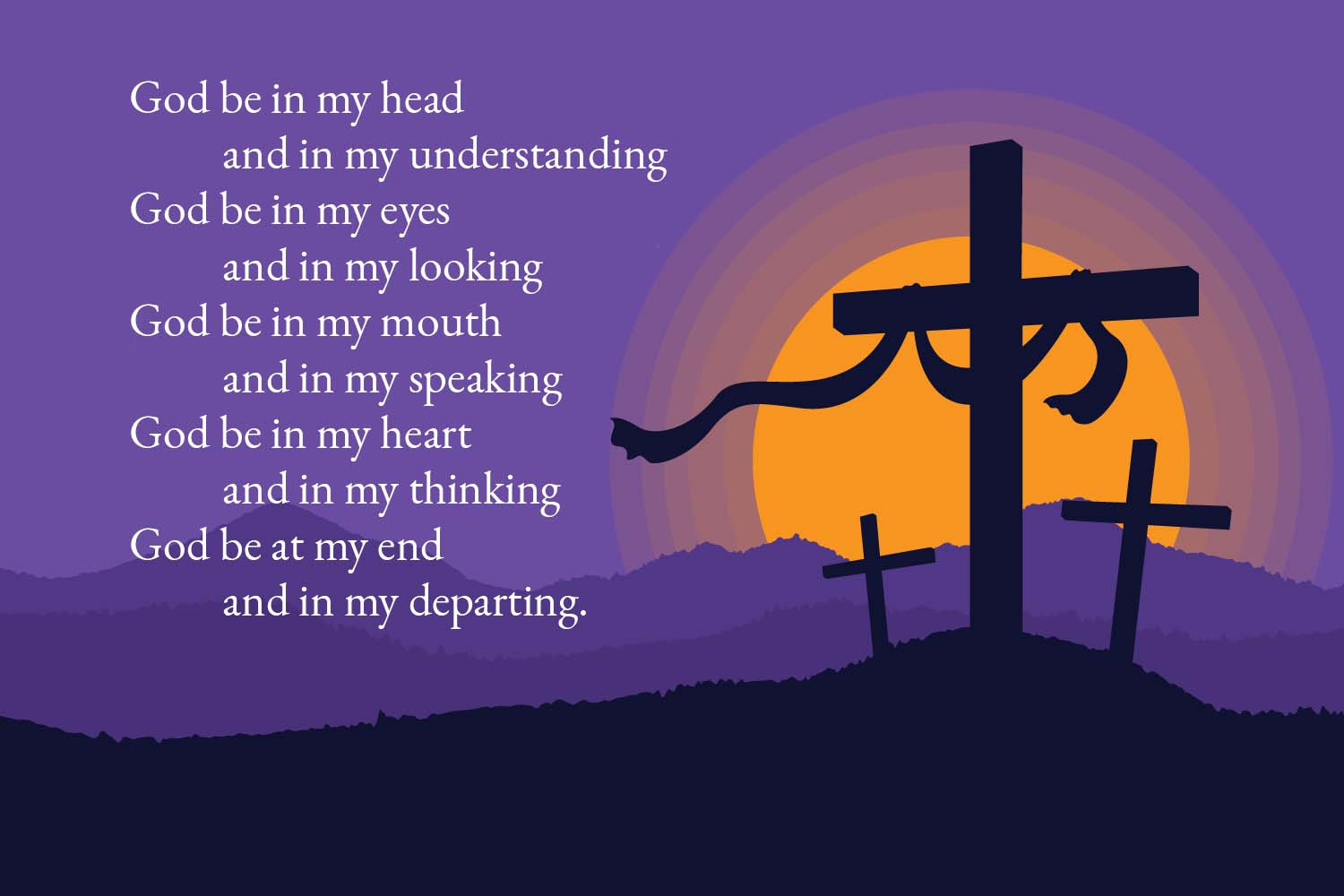For Lent, we are going to explore a prayer dating back to the mid-1500s, and probably earlier, called the Sarum Prayer. Sarum refers to Salisbury in south-central England from whence this prayer hails.
It’s only five lines long:
God be in my head — and in my understanding
God be in my eyes — and in my looking
God be in my mouth — and in my speaking
God be in my heart — and in my thinking
God be at my end — and in my departing.
I’m going to share my insights about this marvelous prayer. It succinctly addresses our daily life and the end of our life, yet with such grace and a sense of confidence. I also recommend that you get a copy of Ken Wilson’s book, God be in my Head: the Sarum Prayer. I’ll put the book’s page numbers like so, “(X),” so you can follow along with yours.
Ken points out the many characteristics that make this such a wonderful prayer. I wholeheartedly agree with Ken and think you will, too. It’s short, old, physical (dealing with our senses and mortality). The Sarum Prayer is easy to remember, mystical, and very importantly, genderless. God is not a he or she. God is God (3). I love this because it reminds us that God is so much bigger than us mortals, our earth, our universe, our galaxy.
Another of Ken’s major insights revolves around the prayer’s simplicity. As we memorize it, we just move down the head from the crown (the brain), to the eyes, to the mouth, to the heart, and then finally, to our departure. Ken says, “a lot of insecurity about praying is a product of our culture and not just our own doing. We live in an era deeply shaped by the pursuit of mastery, of technological wizardry and scientific achievements that were hard to imagine not so long ago…It’s left us a bit lacking in confidence to proceed (6).”
I agree. This prayer “takes the pressure off,” as it were. We don’t have to be accomplished to the nth degree to learn this prayer and to use it as a means of getting closer to our Creator. It’s right here for the praying!
The prayer is the last thing I say to myself before I go to sleep.
The ancient go-to prayers
As an Episcopal priest, nearly every time I lead worship, the congregation reads (but usually recites) the Nicene or Apostles’ Creed. For those of us who regularly attend church, we have these prayers memorized (which I think enhances them). The repetition causes these beloved statements of faith to become part of our “faith DNA.” the memorization does not mean that it has become rote for the faithful. It means we have inwardly digested these sacred words and they have become part of us. Praying shapes believing, and praying shapes our behavior.
The creeds are ancient, and as Ken says, they’re from a much different era, 1600-1700 years ago. Folks living in 300/400s CE did not think at all about stuff we worry about all the time (17).
It helps us to have the “old stand-bys” because they’ve withstood the test of time. They’re like a warm blankie on a frigid Michigan winter night. The Sarum Prayer qualifies as a proper “go-to” prayer. It’s easy to recall and so eloquently addresses the human condition.
“Meditate this prayer”
We can “meditate” this prayer by slowing it way down and incorporating our breathing with the two halves of the line.
It’s easily done by breathing in and praying, “God be in my Head.” Breathe out by saying, “and in my understanding.”
Ken recommends recalling this first line throughout your day as you are able (21). Perhaps even repeat the first line 10x but say the other four just the once. Focus on God be in my Head this first week of Lent. Let it become absorbed by that slow, intentional repetition.
For me, I imagine this line is like blessed oil that flows from the top of my head and down my body. Let this emollient-as-phrase soften you. Allow it to be soaked up by your mind, body and spirit. Let it become internalized as part of your being, as part of your essence.
Christ calls us to deepen our understanding of others
One of the most powerful insights from Ken reveals that this prayer calls us to listen deeply to one another, to understand them. We all have a deep need to be heard, to be understood. I’ve been struck by how Jesus had a regular practice in ministry to find out what others needed.
Jesus often asked another, “What do you seek from me?” This is a profound form of understanding. It can’t happen without some humility (24). Asking what’s needed affirms the other’s personhood, and we need that so much at present. Think of how humble Jesus was in seeking understanding from another even though he likely already knew the answer. The Son of God asked others how he could help instead of deciding for himself.
The Sarum prayer prepares us to seek this level of understanding as a powerful spiritual practice (23). How wonderful!
The power of this prayer does something else for us — it helps us develop what Ken refers to as an “open theory of mind.” Ken cites Stanford anthropology professor Tanya Luhrmann, who studies how people think they experience the spiritual realm. Luhrmann’s research suggests that those who encounter the divine in these ways are healthy, and she distinguishes them from people who suffer from profound mental health issues.
Thin places on earth as in heaven
Rather than only viewing the world as rational and confined to the natural word and our bodies,
Those who are open to experiencing God adopt a theory of mind as semi-permeable to divine or other spiritual influences. Our thoughts may be inspired, shaped, triggered, informed, by divine energy and such thoughts may easily co-mingle with our own thoughts — all inside our head (28).
However we decide to approach this prayer, whether repeating the first line, or saying it all once, it is certainly a prayer that will bring us closer to God, especially with consistent use. Experiment with, and make it your own.
Blessings on your Lenten journey.+





